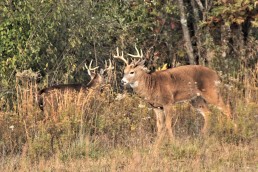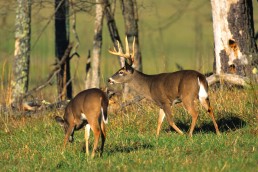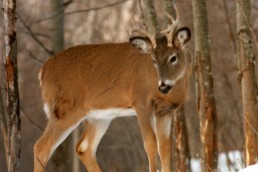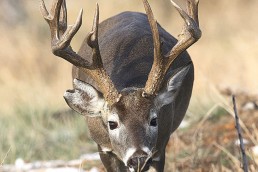Look for Secretive Bucks Early
SHARE THIS POST
There is no clear-cut instruction manual explaining how to tag mature bucks. To tag a deer, we must spend lots of time hunting. Occasionally, luck plays a role. But, concentrated efforts and time in the woods presents numerous opportunities. Master hunters have eventually learned that bucks are tough customers. Now you see him! Now you don’t? It’s the nature of big-racked bucks. There’s no doubt. If ever there was a most secretive animal that walks this earth, it has to be a mature whitetail buck.
Hunters can’t confront senior bucks if they aren’t where these bucks reside. Therefore, it’s important to locate mature deer by gaining land access and scouting well before legal season. Importantly, don’t continuously visit hunting spots until you hunt. Leaving any offensive human odors shuts down opportunities. Also, keep your spots secret from others. Too much human traffic can cause bucks to change habits or move to other areas.
Big rack hunters should be as private as the bucks they pursue. Deer quickly learn to pattern hunter activities. This is why, whenever hunters eat lunch and rest, they lose productive time if they don’t remain in the woods. Bucks are always somewhere within their core area, at any given time. Deer are still on the move, even if hunters aren’t. They don’t leave when the weather turns nasty, or hunting pressures are constant. They simply adjust. Hunters should, too. The more time we are afield, the better our chances of encountering bucks.
No rules for big bucks
Successful deer hunters learn big-racked bucks don’t play by the rules. Therefore, they don’t hunt like everyone else. They try anything and everything they can legally devise and spend lots of time in the woods. Certainly, mature buck hunting involves time and persistence.
It quickly become obvious that mature bucks don’t live like does, or smaller bucks, either. They have their own methods of survival. Throughout much of any year, bucks are loners unless they mingle with other bucks. Therefore, hunters can up their odds at outmaneuvering savvy bucks by focusing on deer survival habits and hunting where and when bucks are more frequent.
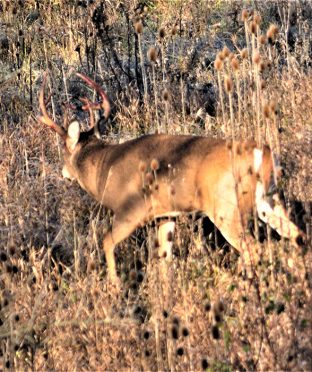
One step is to locate landscape depressions…funnels…and hunt them with cautious intent. Search these funnels for ambush points where mature bucks feel comfortable traveling, away from human & predator view. Then, always honor wind direction as you approach and hunt a location. Sometimes it’s beneficial to set up more than one tree stand or ground blind to accommodate changing wind directions. But, even mature bucks seek food, water, privacy, and secluded bedding. They seek dense foliage habitats for concealment, many types. Never overlook hardwood ridge tops. They are ideal buck travel routes and bedding niches because deer can view the landscape below and around them. Importantly, when thermal air currents flow “up” hillsides, this gives them more scenting options.
Are you enjoying this post?
You can be among the first to get the latest info on where to go, what to use and how to use it!
Breeding bucks a best bet
Unless bucks are aggressively chasing does, we seldom see them. They will bed down early, then become active later in the evening. Be on a stand adjacent to known bedding as early as possible during the morning. Remain in the woods until the last legal minutes of daylight. Get off the beaten path, too. Go deep, then deeper. The term “nocturnal” buck applies to open areas. A buck might appear nocturnal in the open fields where you hunt. But, he is active somewhere. And, it’s typically away from humans, deeper into dense cover.
Deer are partial to comfortable, interior habitats for food and water, as well as security. If the habitat hasn’t been altered by human activities, this reality spans time. It can be true from day-to-day, and year-to-year. When mature bucks find a comfortable location that has the natural components they need, and landscape features don’t change, they will probably rely on these locations many times. But, when something is out of place, they notice the change instantly! Humans believe we are the masters of intelligence. But, a big-racked buck usually has the upper hand whenever you enter his domain. Not that they can reason and solve problems. But, their senses, age experiences and habitat familiarity combine to enable them to live longer.
Key in on isolated locations
There’s no doubt a major key to finding bucks is their location. Such as, isolated pockets far from humans. Bow hunters work these niches before the chaos of gun season, when gun hunters scour the land for “doe happy” bucks. Although mature bucks aren’t prone to making mistakes, when they accompany sexually active does, their senses can sometimes be off-balance. Watch for locked-up bucks guarding their estrus doe(s).
Whenever hunters spend several days hunting away from intense human activities, our senses become keener. We eventually perceive odors that seem more acute. Our hearing detects sounds that have been dulled by our citified environments. And, our eyes see shapes, colors and movements that typify a deer’s environment. If we spent every day living in a reduced human environment, our senses would become “super” acute. Now, you can understand how well equipped whitetails are at merging with their habitats.
Undoubtedly, to score on mature bucks we must spend lots of time hunting. We can’t tag bucks until we see them. Therefore, concentrated efforts and time in the woods improve success. Then, we determine what motivates and moves bucks, like food sources, estrus does, and habitat usage.
Now you see him! Now you don’t? It’s the nature of big-racked bucks. There’s no doubt. If ever there was a most secretive animal that walks this earth, it has to be a mature Whitetail Buck. I’ve wondered, though. Is there an equation for big rack hunting? There might be through a better understanding of their living habits, and by spending more time hunting.
MWO
SHARE THIS POST
Did you enjoy this post?
You can be among the first to get the latest info on where to go, what to use and how to use it!
Bob Grewell
Bob “Greenie” Grewell has written about and photographed the outdoors for 40 years. He’s travelled throughout the U.S., Canada, the Arctic Circle, as well as Germany and Denmark. He has written a book on hunting dogs and contributed articles and photography to others. He currently focuses on deer and turkey articles, and wildlife photography.
